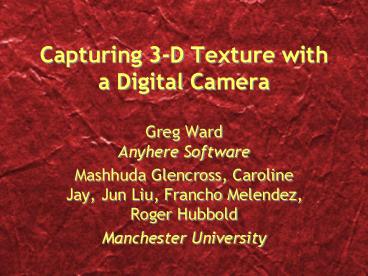Capturing 3D Texture with a Digital Camera PowerPoint PPT Presentation
Title: Capturing 3D Texture with a Digital Camera
1
Capturing 3-D Texture with a Digital Camera
- Greg WardAnyhere Software
- Mashhuda Glencross, Caroline Jay, Jun Liu,
Francho Melendez, Roger Hubbold - Manchester University
2
Depth Hallucination The Short Story
- Acquire Textured surface model
- From a single view
- Using only a digital camera and a flash.
3
Why Do We Want Depth?
- Classical Texture Mapping
- Images mapped to 2D geometry
- No self-shadowing/silhouette detail
- Real-world textured surfaces
- Visually rich, changes with view and lighting
- Common in nature and the built environment
- Aesthetics / ornamentation
4
Real-World Examples
5
Depth Hallucination Method
- Steps
- Capture flash / No-flash image pair
- Estimate Albedo
- Estimate a shading image
- Calculate depth
- Assumptions
- Diffuse/sky illumination
- Global curvature ignored
- Specular reflectance removed
6
(No Transcript)
7
Albedo Estimation
- Starting with flash / no-flash input pair
- Correct for Ambient lighting using no-flash image
- Correct for vignetting using flash calibration
image - Result Albedo map
If (j) Id (j)
8
Compute Shading Image
9
Depth Estimation from Shading Image
- We formulate a hypothesis about local surface
structure
10
Above/Below Plane Models
- Above plane model
- Below plane model
11
Combined Surface Model
12
Apply at Multiple Scales
13
Simplified Capture w/o Flash
- Histogram Matching
- Needs exemplar model
- Single diffuse-lit photo
- Match histograms
- Create rendering
14
Validation
- First user study
- Rank sequentially presented images
- Photos 3.97
- Relit images 3.22
- Histogram matched 2.98
15
Validation
- Second user study
- Select most plausible surface
- No significant difference in peoples subjective
choices
16
Limitations
- Our method will fail if
- Surface geometry cannot be represented as a
height field - Daylight is heavily biased towards one dominant
direction - Surface contains highly reflective or translucent
materials
17
Conclusion
- Simple method
- Results like photographs
- 75 of participants rated our images more likely
to be photos - Participants unable to decide if renderings of
hallucinated depth or laser-scans more plausible
PowerShow.com is a leading presentation sharing website. It has millions of presentations already uploaded and available with 1,000s more being uploaded by its users every day. Whatever your area of interest, here you’ll be able to find and view presentations you’ll love and possibly download. And, best of all, it is completely free and easy to use.
You might even have a presentation you’d like to share with others. If so, just upload it to PowerShow.com. We’ll convert it to an HTML5 slideshow that includes all the media types you’ve already added: audio, video, music, pictures, animations and transition effects. Then you can share it with your target audience as well as PowerShow.com’s millions of monthly visitors. And, again, it’s all free.
About the Developers
PowerShow.com is brought to you by CrystalGraphics, the award-winning developer and market-leading publisher of rich-media enhancement products for presentations. Our product offerings include millions of PowerPoint templates, diagrams, animated 3D characters and more.

